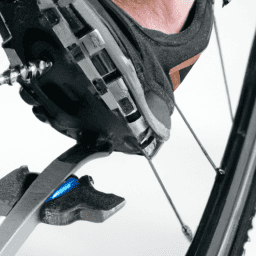Choosing between steel and aluminum frames depends on your riding style and priorities. Steel offers a durable, smooth, and comfortable ride with great repairability, ideal for long-distance and endurance cycling. Aluminum makes bikes lighter, responsive, and low-maintenance, perfect for racing, commuting, or casual riders. Understanding how each material affects performance, durability, weight, and cost will help you find the best fit. Explore further to get the full picture and make an informed choice.
Key Takeaways
- Steel frames are heavier but offer superior durability, comfort, and ease of repair compared to lightweight, corrosion-resistant aluminum frames.
- Aluminum frames provide a stiffer, more responsive ride with better aerodynamics, ideal for racing and performance riding.
- Steel absorbs road vibrations, resulting in a smoother ride, while aluminum transmits more shocks, leading to a harsher experience.
- Steel frames tend to be more expensive and easier to repair, whereas aluminum offers cost-effective, low-maintenance options with innovative design flexibility.
- Choose steel for durability and comfort in long-distance and touring bikes; opt for aluminum for lightweight, agile, and low-maintenance performance cycling.
Key Differences in Material Composition and Manufacturing Processes
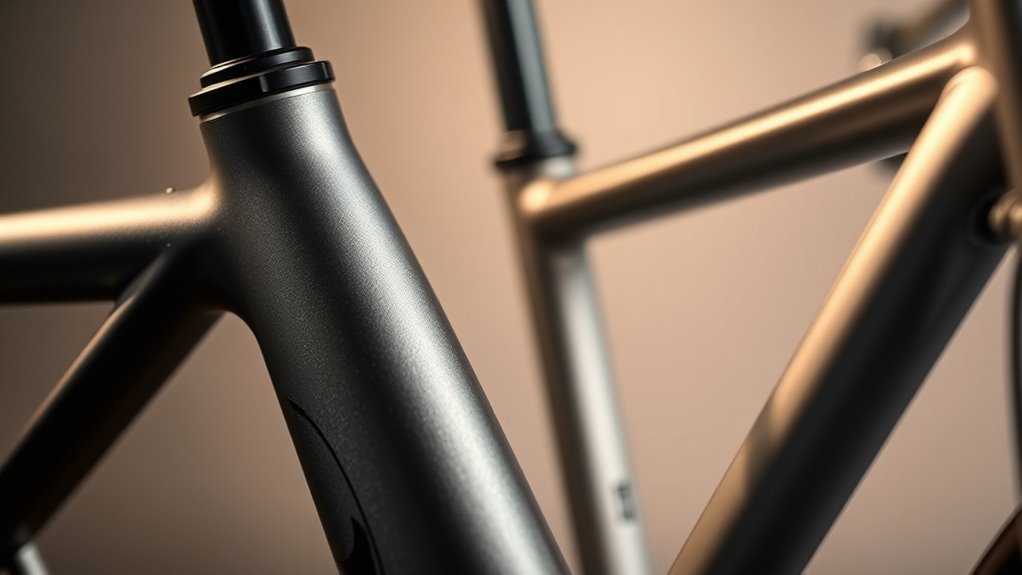
Steel frames are typically made from high-quality alloys like chromoly (such as 4130), which are shaped through welding or lugged construction methods. This manufacturing process emphasizes craftsmanship, where steel tubes are joined using brazing or welding techniques to create durable, repairable frames. The alloy composition gives steel its strength, flexibility, and longevity, making it a traditional choice for many cyclists. In contrast, aluminum frames are produced by alloying aluminum with elements like silicon and magnesium, then shaping the tubes through extrusion and hydroforming methods. These modern manufacturing techniques allow for complex, aerodynamic designs that optimize strength-to-weight ratios. While steel manufacturing relies on time-honored methods, aluminum benefits from automated processes, resulting in different performance characteristics and construction approaches. Additionally, the rise of remote collaboration in manufacturing and design processes has accelerated innovation in both materials. Advances in manufacturing technology continue to influence the development of lightweight and durable cycling frames. Furthermore, ongoing research into material fatigue helps improve the longevity and safety of both steel and aluminum frames. Understanding the material properties of each type aids in selecting the best frame for specific riding conditions and preferences. For example, the welding techniques used in steel frames can be refined to enhance durability and repairability over time.
Impact on Bike Performance and Ride Quality
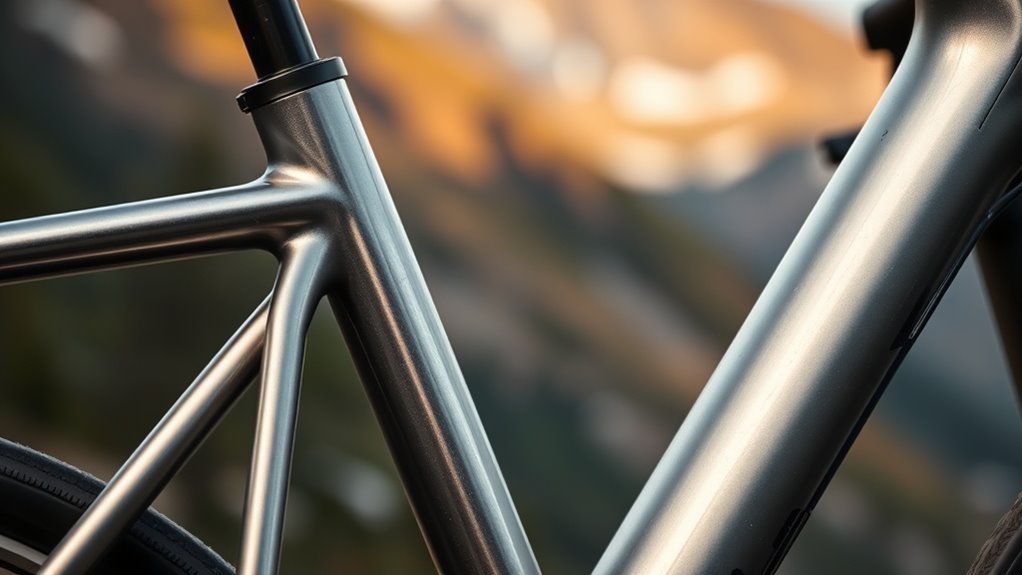
Your choice of frame material directly affects how your bike feels and performs on the road. Steel offers a smoother, more comfortable ride, especially on rough surfaces, while aluminum delivers sharper handling and quicker responsiveness. Understanding these differences helps you pick the right frame for your riding style and terrain.
Ride Comfort Differences
Because of its natural flexibility, steel frames absorb road vibrations more effectively than aluminum, resulting in a smoother, more comfortable ride. This damping ability reduces rider fatigue, especially on rough terrains or long-distance rides. Steel’s inherent softness makes for a more forgiving experience, ideal for endurance and touring cyclists. In contrast, aluminum frames are stiffer, transmitting more shocks and creating a harsher ride. While modern aluminum designs incorporate tube shaping to improve comfort, they still generally feel firmer than steel. Your ride comfort depends heavily on frame material, with steel providing a more cushioned, relaxed experience. Additionally, steel’s self-healing properties can help the frame withstand minor impacts without sustaining significant damage, contributing to its durability over time. The ability of steel to absorb vibrations enhances overall ride quality and rider comfort, especially during extended periods of cycling. Furthermore, steel’s flexibility allows for easier customization and repairs, making it a preferred choice for many cyclists seeking longevity and comfort. Moreover, steel frames often feature welded joints that contribute to their strength and durability over years of use. According to mammography guidelines, the choice of frame material can also influence the overall weight and handling of the bike, impacting rider performance and comfort.
Handling and Responsiveness
Handling and responsiveness are considerably influenced by frame material, shaping how a bike performs in different riding conditions. Steel frames offer a more forgiving and responsive ride thanks to their flexibility and damping qualities, which absorb road vibrations and improve ride quality. Aluminum frames are stiffer, providing quicker power transfer and more immediate responsiveness, making them ideal for sprinting and aggressive riding styles. The high stiffness-to-weight ratio of aluminum reduces energy loss during pedaling, enhancing responsiveness on performance bikes. Steel’s flexibility allows for better handling on rough terrain, delivering stability and control, especially off-road. Conversely, aluminum’s rigidity can create a harsher ride, reducing comfort over long distances or uneven surfaces. Your choice impacts how responsive and comfortable your ride feels across different conditions.
Durability, Repairability, and Long-Term Maintenance
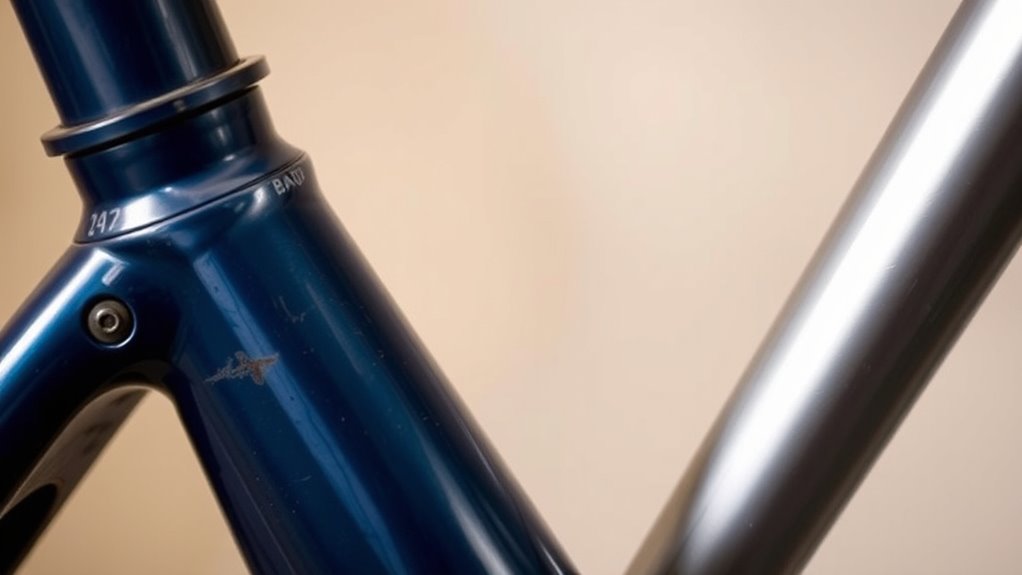
Steel frames are easier to repair and tend to last longer with proper maintenance, thanks to their weldability and flexibility. Aluminum frames, however, are more challenging to fix and typically wear out faster, often needing replacement after a few years. Keeping both materials in good shape requires regular care, like rust prevention for steel and inspections after impacts. Additionally, remote work habits such as proper workspace management can influence the longevity of materials by reducing unnecessary stress or damage. Understanding the importance of performance tuning can also help in maintaining optimal material condition over time.
Repairability and Longevity
When it comes to repairability and longevity, steel frames stand out for their ease of repair and durability. Their inherent toughness allows them to withstand impacts and fatigue, often lasting a lifetime with proper maintenance. Skilled welders can fix dents, cracks, or breaks, restoring the frame to near-original strength. Additionally, steel’s natural flexibility means it can be bent back into shape if misaligned, further extending its lifespan. This integration of neural networks in manufacturing processes can also help predict when repairs might be needed, enhancing maintenance planning. Compared to aluminum, steel frames are easier to repair and maintain over the long term. To maximize longevity, you should regularly inspect for rust and keep the frame properly protected. Here’s what you need to know:
- Welders worldwide can readily repair steel frames
- Steel’s toughness resists impacts and fatigue
- Flexibility helps extend lifespan
- Proper maintenance ensures durability
Corrosion Resistance and Care
While steel frames are renowned for their repairability and durability, they require regular care to prevent corrosion and guarantee long-term performance. Steel is more prone to rust if not properly coated or maintained, so you need to inspect it regularly and apply protective treatments like anti-rust agents such as Fluid Film. Storing your bike in dry conditions also helps prolong its lifespan. In contrast, aluminum naturally forms a protective oxide layer that offers excellent corrosion resistance, especially in humid environments like Singapore. This reduces maintenance needs over time, making aluminum more convenient for long-term care. Although both materials can be repaired after damage, aluminum repairs are more complex and often lead to replacement, whereas steel can be welded and restored more easily with proper upkeep. Furthermore, data privacy challenges in automation and manufacturing can influence how maintenance data is collected and managed. Additionally, implementing preventative maintenance strategies can significantly extend the lifespan of your bike frame regardless of material. Incorporating AI-driven diagnostics can also help identify potential issues early, reducing costly repairs and downtime.
Weight, Handling, and Efficiency Considerations
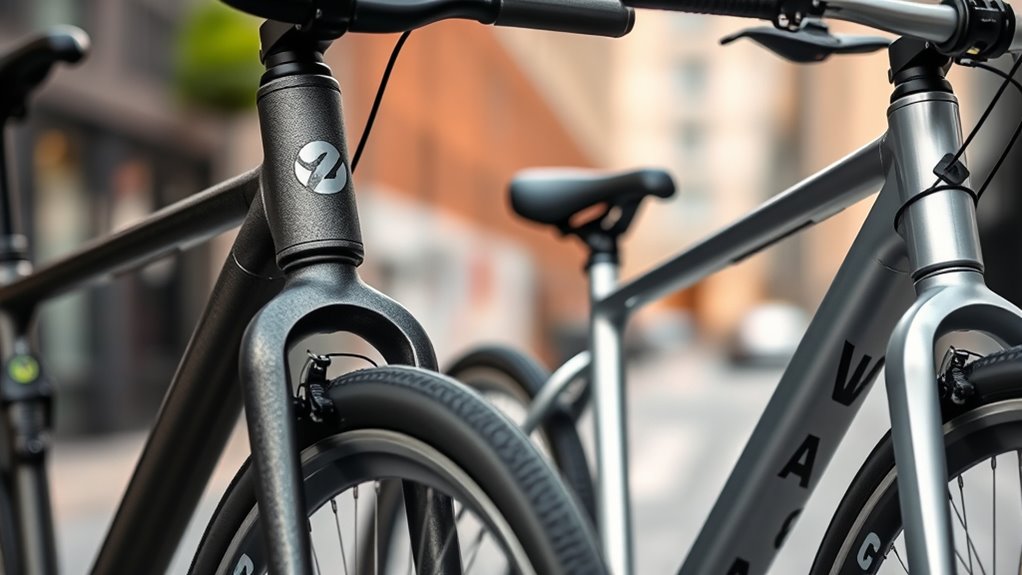
Aluminum frames are substantially lighter than steel, with a density of about 2.71 g/cm³ compared to steel’s 7.87 g/cm³, making them ideal for riders seeking a lightweight setup. This significant weight difference enhances your overall handling, especially during climbs and sprints. Aluminum’s high stiffness-to-weight ratio provides quick, responsive handling, helping you feel more in control. Its rigidity also boosts efficiency by transferring pedaling energy directly to the wheels. Additionally, aluminum frames often incorporate heat pump technology, which can improve the bike’s thermal management and overall performance.
Aesthetic Styles and Design Flexibility
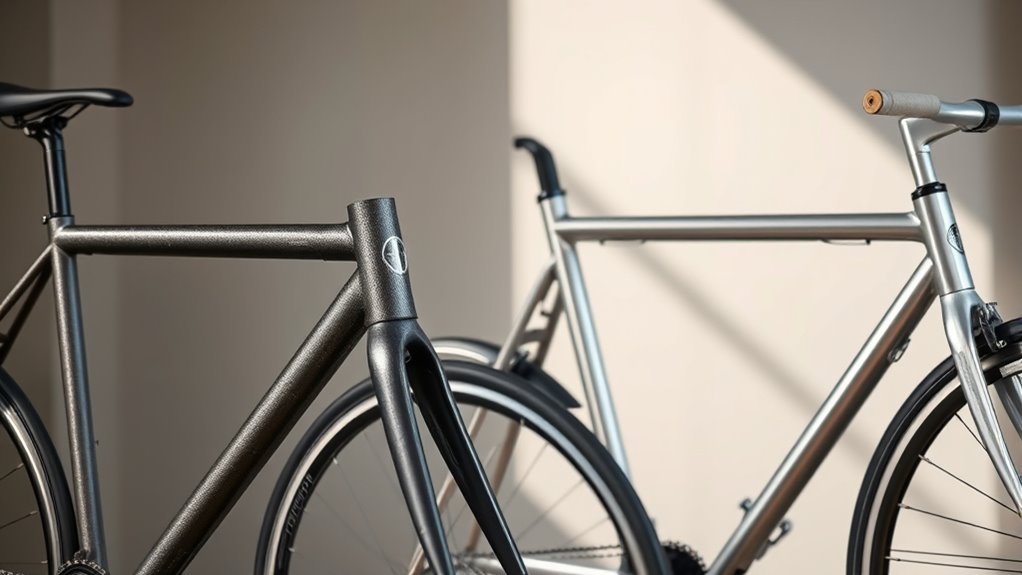
Aluminum frames offer sleek, modern aesthetics with their ability to be shaped into aerodynamic, intricate designs that catch the eye. Their design flexibility allows for creative, lightweight profiles that emphasize performance and style. You’ll find a wide variety of aesthetic styles, from minimalist to cutting-edge, thanks to aluminum’s malleability. While traditional shapes are common, aluminum’s versatility enables the incorporation of complex geometries and detailed features like fillet brazing or custom-shaped tubes. Additionally, aluminum’s lightweight nature makes it ideal for applications where ease of handling and transportation are essential. This versatility also allows for innovative design possibilities that can be tailored to specific performance needs or visual preferences. The ability to achieve precise detailing further enhances aluminum’s appeal for distinctive, eye-catching frames. Moreover, aluminum’s corrosion resistance ensures durability in various environments, extending the lifespan of the finished product. Steel frames, on the other hand, blend classic and contemporary looks, appealing to those seeking a vintage or handcrafted vibe. Both materials provide options to match your preferred aesthetic style, but aluminum’s ease of shaping makes it especially suited for innovative, modern designs that stand out visually.
Cost, Value, and Suitability for Different Riding Styles
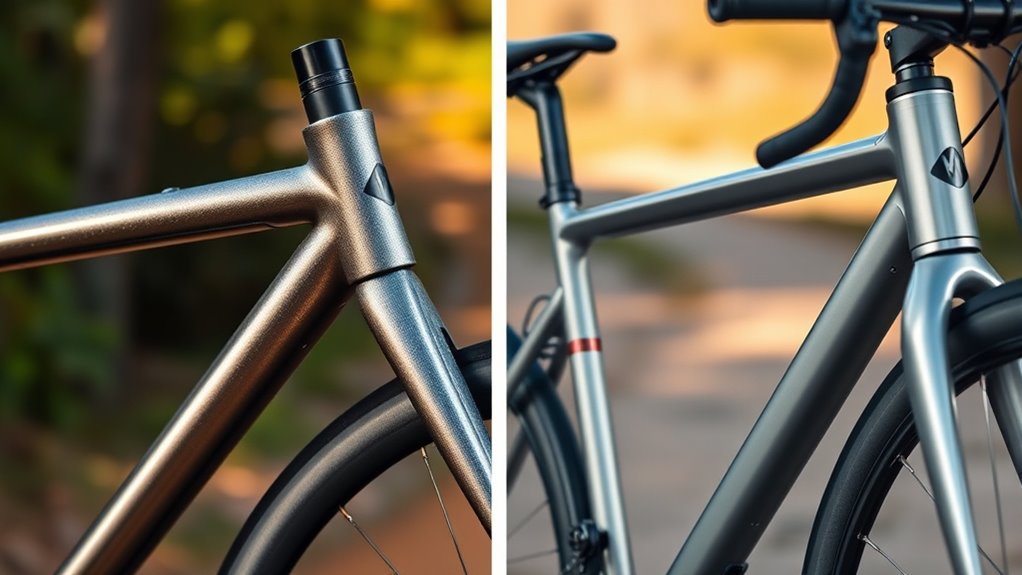
Choosing the right frame material depends heavily on your riding style and budget. Steel frames tend to be more expensive, especially in high-end builds, due to their durability and craftsmanship. Aluminum offers better value at lower and mid-range price points, giving you lightweight performance without the steep cost. For long-distance touring and endurance riding, steel’s durability and easy repairability make it a top choice despite the higher initial investment. Aluminum frames are perfect for racing, commuting, or casual rides where affordability, weight savings, and corrosion resistance matter.
- Steel suits riders prioritizing durability and comfort, even at a higher cost.
- Aluminum provides lightweight efficiency at a more accessible price.
- Long-distance cyclists often prefer steel for its longevity.
- Speed-focused riders benefit from aluminum’s agility.
Which Material Suits Your Cycling Needs Best

Determining which material suits your cycling needs depends on your priorities—whether it’s durability, weight, comfort, or maintenance. If you value a sturdy, long-lasting frame that’s easy to repair, steel is your best choice. Steel frames provide a comfortable, springy ride by absorbing vibrations, making them ideal for long-distance touring and custom builds. On the other hand, if you prefer a lightweight bike that enhances performance and requires less upkeep, aluminum is better. Aluminum frames are considerably lighter, usually 1-2 pounds less than steel, and resist corrosion, reducing maintenance needs. Consider your riding style and environment—steel for durability and comfort, aluminum for lightness and low maintenance—to choose the material that aligns with your cycling needs best.
Frequently Asked Questions
Which Frame Is Better, Aluminum or Steel?
When choosing between aluminum and steel frames, think about what matters most to you. If you want a lightweight bike for faster rides, aluminum’s your pick. But if durability, comfort, and long-term value matter more, steel suits you better. Consider your riding style and priorities—there’s no one-size-fits-all answer. You’ll find the best frame by matching its strengths to your needs and preferences.
What Are the Disadvantages of Aluminum Bike Frames?
Aluminum bike frames can feel like a fragile glass sculpture, easily chipped by impacts. You might find they’re less durable over time, prone to fatigue and sudden cracks. Repairs are tricky because welding requires experts, often leading to frame replacement. Plus, their stiff nature transmits road shocks harshly, and they’re susceptible to corrosion if the protective layer breaks. All these factors mean aluminum frames demand careful handling and maintenance.
How to Visually Tell the Difference Between Aluminum and Stainless Steel?
You can tell aluminum from stainless steel by examining the surface finish and weight. Aluminum typically has a smooth, matte or anodized look, and feels lighter with thinner tubing. Stainless steel often appears darker, with a polished or brushed surface, and is heavier with thicker tubing. Scratches on aluminum are usually silvery or whiteish, while steel scratches tend to be darker or grey, helping you identify the material easily.
How to Tell if a Bike Frame Is Steel or Aluminum?
To tell if a bike frame is steel or aluminum, start by inspecting the surface. Steel frames often have visible welds and a painted or coated finish, while aluminum frames tend to have smooth, matte or glossy surfaces with fewer welds. Perform a magnet test—if it sticks, it’s likely steel. Also, listen for a dull sound when tapping the frame or check for markings or stickers indicating the material.
Conclusion
Choosing between steel and aluminum frames is like picking the right tool for a job—you need what fits your riding style and priorities. Steel offers durability and a smooth ride, while aluminum provides lightweight agility. Think about your terrain, maintenance willingness, and budget. By understanding these differences, you can find the perfect match that feels like an extension of yourself on every ride. Ultimately, the best frame is the one that keeps you pedaling happily and confidently.









